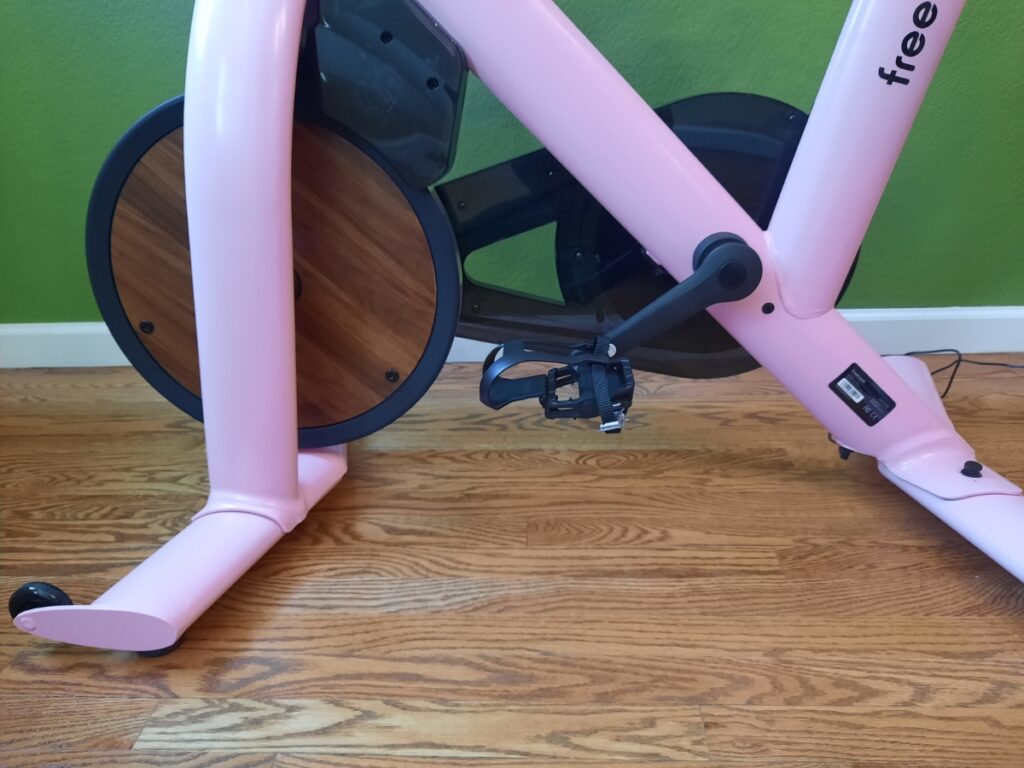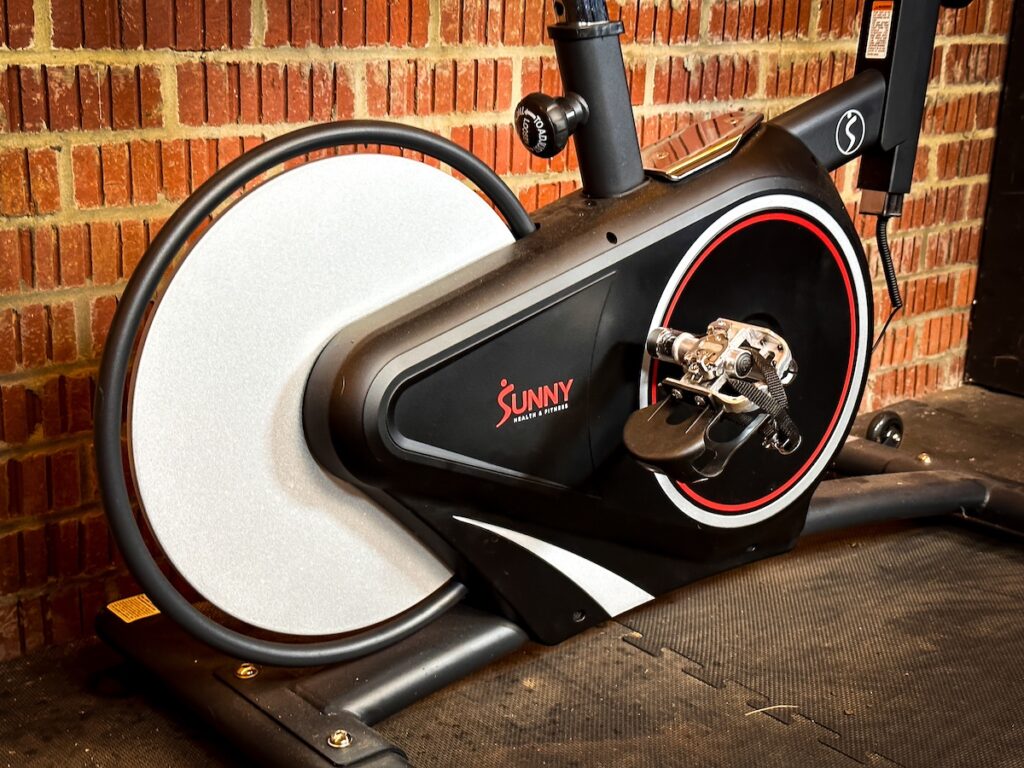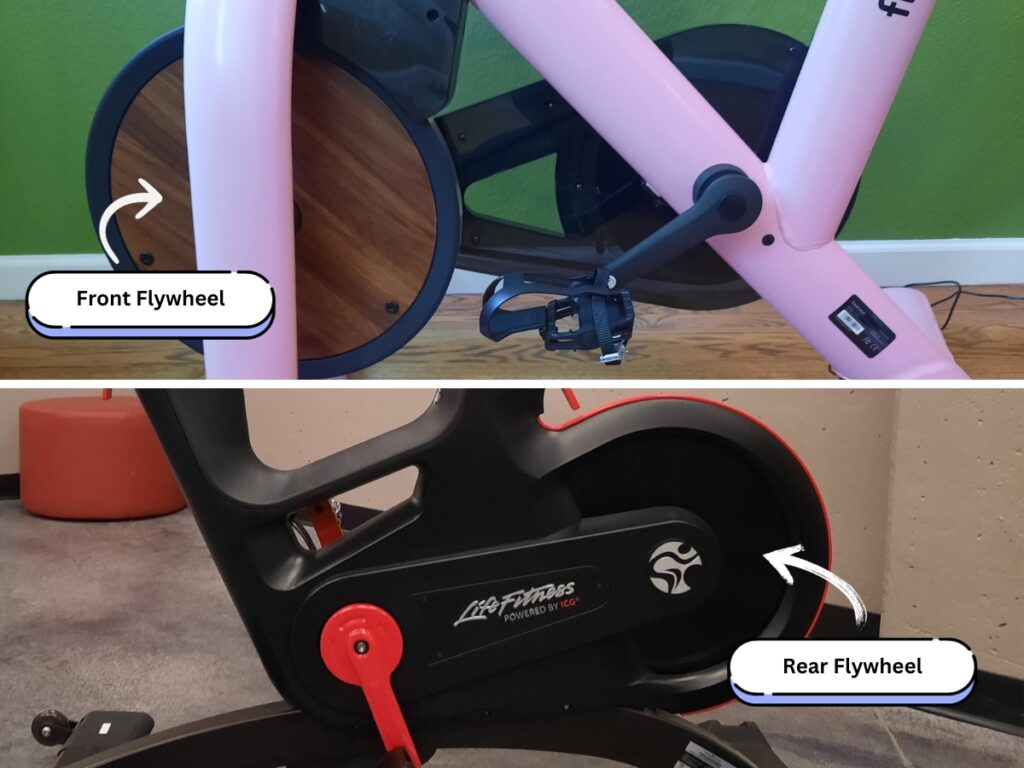
Certified Spinning® Instructor & CPT
Spin bikes are known for their sleek design and spinning flywheels. The flywheel is one of the most critical components of these cycles and one of the most debated topics on whether a front or rear flywheel is best. With so many opinions on which placement is better can be confusing. Read on as we break down everything you need to know.
| Front Flywheel Placement | Rear Flywheel Placement |
|---|---|
| Friction or Magnetic Resistance Options | Magnetic Resistance |
| Various Price Points | More Expensive |
| Higher Chance of Sweat Corrosion | Lower Chance of Sweat Corrosion |
Front Flywheel
When spin bikes first hit the market, they were initially designed with a front flywheel. Still today, this design is more readily available through a multitude of different manufacturers. Front flywheels weigh approximately 40 pounds. A weighted front flywheel offers an incredibly smooth ride as it helps to drive inertia and mimics an outdoor riding experience.

Pros
Cons
Instructor Tip: Always make sure to wipe down the flywheel thoroughly and anywhere else sweat could drip on your
bike after every ride to help decrease potential sweat corrosion.
Katie Pierson, Indoor Cycling Instructor
Rear Flywheel
A rear flywheel is a lightweight flywheel located behind the saddle of the cycle. This placement is a newer technology that offers an almost silent riding experience since they are designed with magnetic resistance. Many high-end models being produced today are designed with a rear flywheel.

Pros
Cons
Front vs. Rear Flywheel Head-to-Head Comparison

Let’s break down how these two flywheel designs compare.
Riding Experience
One of the most significant differences between these two flywheel designs is the riding experience. Rear flywheel spin bikes include magnetic resistance, which offers a different feeling than friction that can be available with front flywheel models. There is a delay between when resistance is added or taken off and when it actually is felt through the pedal stroke with magnetic resistance.
In contrast, front flywheels that include friction resistance mimic the feeling of riding an outdoor
Related: Magnetic vs Friction Resistance Indoor Cycles
Personally, if the cycles both have magnetic resistance, I find that the riding experience is very similar if the flywheel is located in either position. For example, I ride a Life Fitness C7 when teaching that includes a rear flywheel, and I own the Bowflex C6, which has a front flywheel. The riding experience for both models is almost identical once the pedals are turning.
Price
Newer technology often comes with a heftier price tag, and rear flywheel cycles are no exception. For example, a budget rear flywheel
Maintenance
Maintenance issues also tend to be less with a rear flywheel placement. Cycles with flywheels in this placement include magnetic resistance and a belt drive-train. Both of these features require little maintenance. Most cycling studios and

Flywheels in the front position often require slightly more TLC. In addition, since the flywheel is located in the “sweat zone,” these bikes are prone to sweat corrosion and drive-train issues that can occur if the
It is important to note that some front flywheel models offer friction resistance. However, friction resistance bikes require more maintenance than magnetic ones since the pads eventually wear out.
Sweat Protection
A rear flywheel spin

Conclusion
There are excellent cycles in both the front and rear flywheel categories. However, deciding which type of resistance option you prefer should help determine which placement is better for you. We always recommend testing the cycles you are considering to see which option feels best for you. Happy riding!

Great explanation on the types of spin (indoor exercise bikes). After reading your well written article I came away with more understanding of what I ‘m looking for in an indoor bike. Not too particular in needing a big monitor since I have a big screen TV and also walking and hopefully biking videos to watch ad I’m biking. One thing I wanted to know before I just before not needing a monitor on the bike was which company has a class dedicated to people not trying to win the Tour de France 😢. Just out for a nice ride to burn calories and keep things in trusting. I guess all the bikes having the magnetic flywheel will mimic riding an outdoor bike. I currently own a powerless recumbent type bike. It’s not for me
The minute you stop pedaling the wheel stops and the monitor dies. Couldn’t be further from the operation of a real out door bike.
Thank you so much for reading my article.
Great question regarding which bike or app might suit your needs the best. Many instructor-led platforms will have various intensity levels of classes that they offer. If you are looking for a bike model without a monitor and do not mind using your phone or tablet, I recommend the digital Peloton app with my Bowflex C6. Many recovery rides on the app, along with instructors like Matt Wilpers, are dedicated to making the rides attainable and enjoyable for beginners or those not trying to train for the Tour de France. I also love how the Bowflex C6 rides and the price point.
If you are looking for a bike that does include a monitor, the MYX II BODi bike or Bowflex VeloCore are great options. These bikes are a little more expensive than the C6 but offer some unique features. For example, the BODi bike comes with a 21.5-inch monitor. In addition, the BODi app has a large variety of classes you desire. The VeloCore offers a different riding experience with the ability for the frame to unlock and sway to mimic riding a real bike. Also, this bike features the JRNY app on its 16” or 22” monitor. The app has a large variety of instructors and the ability to take scenic rides.
One thing to keep in mind is that the monthly membership will be higher on bikes that include a monitor since additional integration is offered with that specific bike. On the other hand, a la carte cycling apps such as the digital Peloton app are more affordable but provide less integration.
We hope this helps and please let us know if we can answer any other questions you may have.